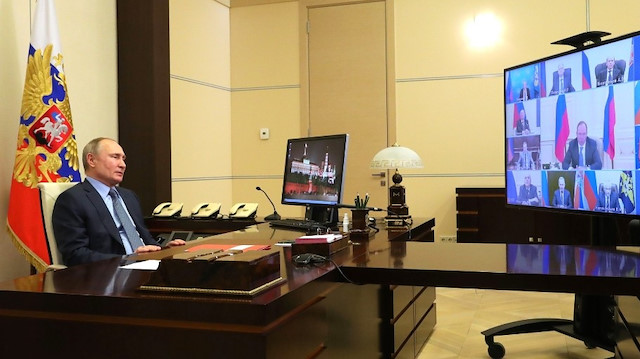
Russian experts say extension of treaty brings stability, predictability in arms control but only for 5 years
Russia and the US announced Feb. 3 the extension of the Strategic Arms Reduction Treaty (New START) for five years until Feb. 5, 2026.
Once part of a larger group of agreements on arms control between the US and the USSR, and later Russia, the New Start is the last pillar that prevents the two countries from relapsing to a new Cold War and unleashing a full-fledged arms race.
The first Strategic Arms Reduction Treaty, START I, signed in 1991, took effect in 1994.
“It was seen as a ground-breaking event, and along with achieving other agreements -- on limitation of deployed anti-ballistic missiles (ABM Treaty), ban of intermediate-range nuclear forces (INF Treaty), and aerial inspections (Open Skies) -- led to a significant ease of tensions, ended the Cold War, arms race and decreased global military risks,” military observer Viktor Litovkin said in an interview with Anadolu Agency.
In recent years the US withdrew from three of the treaties, and during the Trump administration the issue of expanding START’s successor agreement -- the New START signed in 2010 by US President Barack Obama and Russian President Dmitry Medvedev -- remained uncertain, said the expert.
The decision by US President Joseph Biden to extend the treaty for the next five years not only prolongs arms control, but it is perceived as a sign that Washington has returned to a more responsible position in global affairs, stepping back from Trump’s line of denying US obligations to other international players, said Litovkin.
"As for the New START’s importance, it is enough to say it maintains strategic stability between the two leading nuclear powers, which are armed with the largest number of strategic nuclear weapons, almost 90% of the world's nuclear weapons are accounted for by the US and Russia," he said.
Preserving the agreement allows Russia and the US to control the development of each other’s strategic nuclear forces, and cross-check through a verification mechanism -- onsite inspections -- when appointed teams from both countries have the opportunity to visit missile sites and see what is happening, whether the weapons are preparing to launch, to attack and therefore, to lift some mutual concerns and suspicions, and decrease military risks, he said.
"Before testing a missile, both sides must notify each other at least 24 hours in advance, so that neither the US nor Russia would be alarmed that the missile is flying towards one or the other country, that a war is beginning," he said.
Without hindering the creation of new missile systems, the treaty limits the number of nuclear weapons in use and obliges each side to show each other new weapons before putting them into service, providing necessary transparency, said Litovkin.
Also, the agreement opens an opportunity for further dialogue on sensitive topics that worry the signatories, he said.
"This treaty allows us to be fairly open and gives the opportunity to start negotiations on issues that concern both sides: strategic and tactical weapons, treaties from which the Americans withdrew -- on intermediate -- and shorter-range missiles, Open Skies. It is possible to negotiate and return to these agreements.
"This is the continuation of control over the most terrible and powerful weapons that can turn our planet into dust and destroy civilization. This is the significance of this agreement, and that is why there is such agitation around it," said Litovkin.
- Detente for five years
The treaty simply preserves the status quo and is not aimed at detente between Russian and the US, however, it is the first event in a long time that does not escalate tensions between the two countries, military expert Pavel Felgengauer told Anadolu Agency.
The expansion of the treaty is not a signal that the US and Russia are beginning a serious rapprochement, and the extension itself cannot solve the problems that exist -- the main is the loss of trust, he said.
"Nevertheless, both the Pentagon and the Russian General Staff wanted to extend this agreement, but for different reasons. The US cares about maintaining the verification regime -- mutual onsite inspections of nuclear carriers, exchange of telemetry of test missiles launches and other sensitive information. Our General Staff is interested in extending New START, because without it, the Americans can deploy additional nuclear carriers in a short time," he said.
Although both sides want transparency, that does not change the fact that they consider each other an enemy.
“Not that they are going to fight -- they are not, but they are ready to balance on the brink of war,” said Felgengauer.
Another problem is that the treaty is signed only for five years and does not provide further extension.
"And it is not even clear whether it will last all these five years, because any of the parties can denounce it at any time, and the parties have lots of mutual claims.
"In particular, the US insists on involving China, but there are other nuclear-armed countries. Then you need to bring them to negotiations as well. But given the difficulties existed with the extension of the New START, signed between only two countries, the preparation and signing of another arms control agreement in just five years and between many countries seems almost unrealistic," said Felgengauer.
Signing a multinational arms control would be possible only if there was a strong political will of all participants, and there is no such will, so the creation of such a treaty, he said.
Hello, the comments you share on our site are a valuable resource for other users. Please respect other users and different opinions. Do not use rude, offensive, derogatory, or discriminatory language.
The floor is all yours.








